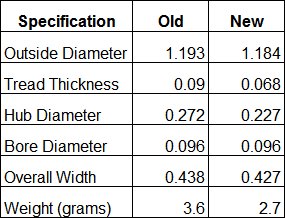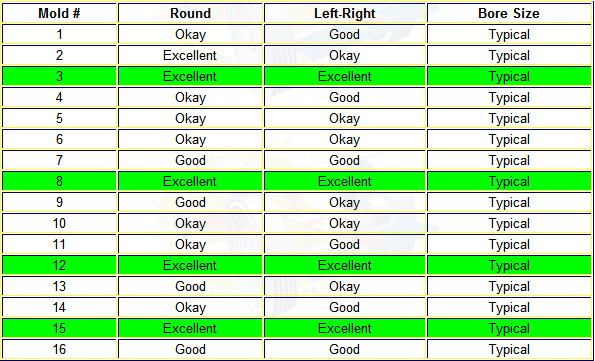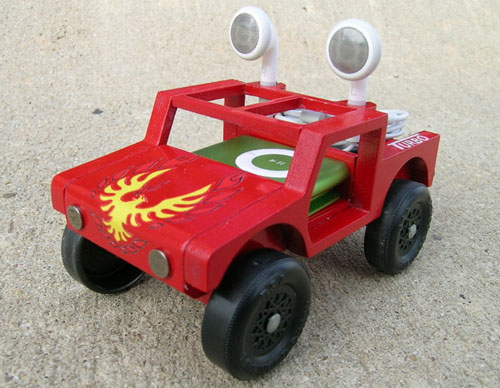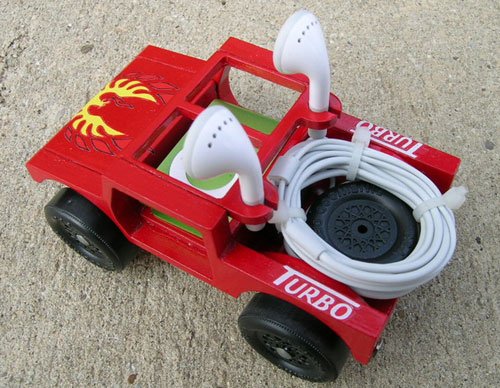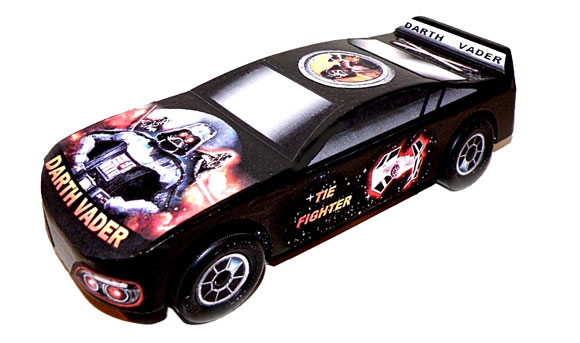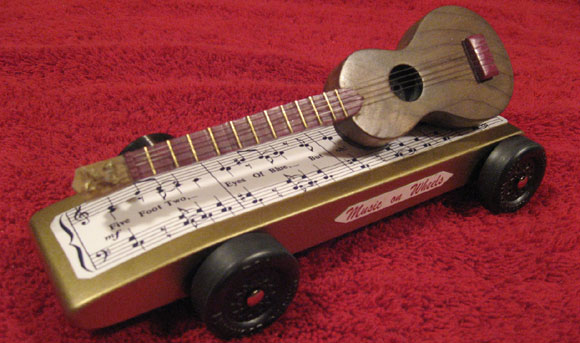– Feature Article – New Cub Scout Pinewood Derby Wheels
– Shop Talk – Measuring for Success
– Pinewood Derby Car Showcase
– Q&A
New Cub Scout Pinewood Derby Wheels
If you follow pinewood derby racing, then you will have heard rumors that BSA is changing the wheels in their Cub Scout Grand Prix Pinewood Derby kit. These rumors started many months ago with an occasional sighting of these reclusive wheels. But in recent weeks, the wheels have become widely available, at least in the replacement wheel packs.
Today, we will take a look at the new wheels, and compare them with the previous wheels. Also, for race leaders we’ll discuss how these new wheels will affect your race.1
New Wheel Specifications
Regardless of the rationale by BSA for creating new wheels (likely cost), the mold designers stayed true to the older design, and did a truly nice job on the molds. The new wheels look very much like the older wheels, but (so far) tend to be more accurate than their predecessors.
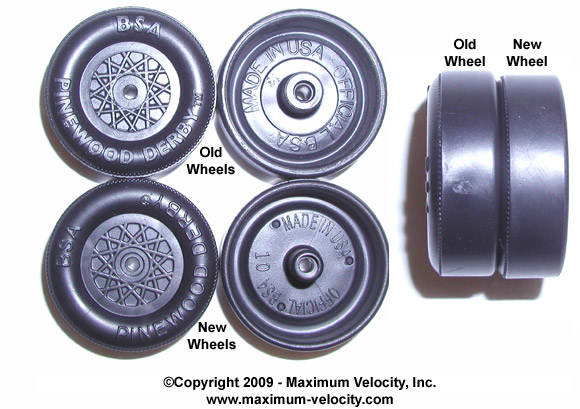
Outside
From the outside, the only obvious differences are the slight font change on the raised lettering, the change from the trademark insignia (TM) to the registered trademark insignia (R), and the addition of a recessed ring in the outer hub. This recessed ring is likely counterproductive to performance, as it will change the contact point with a beveled axle head, resulting in more braking torque.2
Inside
The changes on the inside of the wheel are more apparent. In addition to the font change for the raised lettering, the inner hub is reduced in diameter and coned, and the tread is slightly thinner. These latter changes result in a wheel with less weight (better performance).
Tread Surface
Yes, the mold mark on the tread surface is gone. This is welcome news as less work is needed to prepare a wheel, and the wheels tend to run truer out of the box.3
Comparison With Old Wheels
So, how do the new wheels compare with the old wheels? The basic measurements are shown in the following table. But in summary, the new wheels are lighter, smaller in diameter, and generally more accurate.
All measurements (except weight) are in inches, and are typical numbers.
Mold Comparison
Are there differences in the various molds that produce the wheels? Yes, there is variation, but not as substantial as with the old wheels. The table below gives a comparison of the sixteen mold number.
Notes on measurements:
- Measurements made in August of 2009. Ten wheels from each mold were randomly selected from 2,000 wheels. The wheels were examined and the results averaged.
- In general, all of the wheels are good – much better than the previous wheel version. The difference between the Excellent, Good, and Okay ratings is a few thousandths of an inch.
- The bore size on all mold numbers measured within one thousandth of an inch.
For Race Leaders
Race leaders need to be aware that these wheels will affect your race in several ways.
Rules
Many packs use rules that are very specific as to the treatment that can be applied to wheels. One common rule is a minimum diameter of 1.180. Given that the new wheels are typically 1.184 in OD out of the box, even a tiny amount of tread sanding/polishing will reduce the diameter to less than 1.180. So this minimum diameter number should be reduced to (for example) 1.170 to accommodate the new wheels.
Some packs regulate wheel weight. Obviously, the lower weighted wheel will require a change to the minimum wheel weight.
Finally, some packs do not allow the inner hub to be coned. Since the new wheels come coned out of the box, this rule will need to be changed.
Car Performance
As of this writing, the pinewood derby kits are generally shipping with the older wheels, while replacement sets are generally shipping with the new wheels4, so it is very likely that some cars will be entered in your race with the old wheels, and others with the new wheels. Due to the better accuracy and the lower wheel weight, out of the box the new wheels will generally outperform the older wheels. Therefore, if both wheel types are allowed in the same race, the cars with the newer wheels will have an advantage.
So, a decision must be made at the appropriate level (pack, district, or council) as to whether to require the old wheels, the newer wheels, or run a two-class race (or ignore the issue and let the chips fall where they may). As a side note, if you are entering a car in a race that allows the new wheels, then you certainly want to use them.
Summary
Change is inevitable, and the transition is not always smooth. The new wheels will require a carefully thought out transition during the coming season. If you are involved in running a race, make sure to consider how you will accommodate the new wheels. If you are racing a car then make sure to know the local rules regarding the new wheels, and then use them if you can.
1There is also a rumor that the axle nails are changing, the difference being that the new axles are shorter. However, in all of the new sets we have received, the axles are unchanged. So, if and when we see an axle change, we will let you know the specifics.
2To resolve this issue, DerbyWorx is removing the recessed ring on their machined wheels.
3The mold mark on the tread is replaced with three small mold marks on the inside of the wheel. These can be seen in the photo showing the inside of the wheel.
4But be aware that old and new wheels can be found mixed in a tube of replacement wheels, and will likely be mixed in the kits as well.
Shop Talk
Measuring for Success
Making a pinewood derby car calls for a number of measurements, and marking several cut lines and drilling marks. Although this seems like a simple part of building the car, making accurate measurements quickly and repeatedly takes some practice, the knowledge of a few tips, and the proper tools.
Today, we’ll focus on measurement tips; tools will be discussed in a future Shop Talk.
Making A Measurement
A typical measurement for a pinewood derby car is measuring off the bottom of the block for drilling weight holes in the side or back of the car. Let’s say you want to measure 7/16 inch off the bottom to locate a weight hole. Where do you start the measurement from? Typically, one would align the end of the ruler on the bottom of the block, and then make a mark at the 7/16 inch tick mark. This will work, but it is not necessarily accurate for several reasons. First, the end of the ruler (especially on an inexpensive ruler) is not precisely ground. Second, ruler ends are often a bit chewed up. Finally, it can be awkward to align and hold the end of a ruler on the edge of the block.
A more accurate technique is to align one of the inch marks (typically the 1 inch mark) with the edge of the block, then make the pencil mark at 1-7/16 inches. This will work for any measuring or marking task. But if you are measuring, make sure to subtract one inch to get the correct measurement.
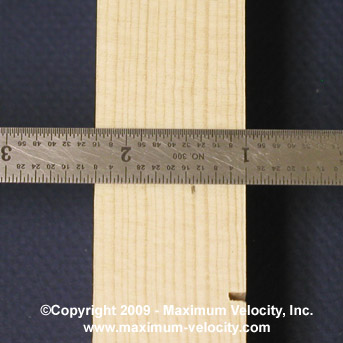
Drawing A Horizontal Line
Let’s say that you want a pinewood derby car to be 7/16 inch thick. Sounds easy; just measure 7/16 up the side, draw a line, and cut. But there are a couple of ways to do this, depending on the accuracy needed. If you don’t need any significant amount of accuracy (e.g., a line is needed for a rough cut), then an easy way to draw the line is to measure at one spot on the block, then use your fingers to guide the drawing of the line. Just place the pencil at the marked location, place the tip of your middle finger along the side of the block, lock your fingers in place and draw.
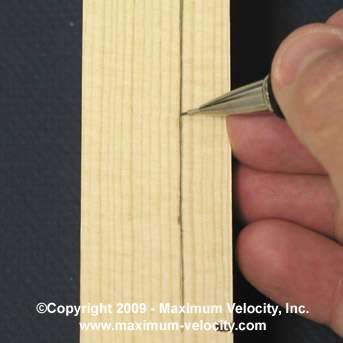
With a little practice, this will result in a reasonably accurate line. If you need to repeat the line (other side of the block, or a different block), just keep your fingers locked and keep drawing.
For a more accurate line, measure at two points on the block, place the pencil tip at one of the marks, slide a ruler against the pencil lead, align the ruler with the other mark, and then draw. If the ruler is firmly held in place, then this will result in a quite accurate line.
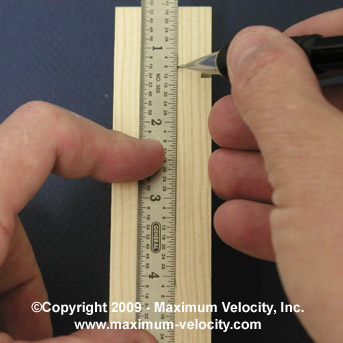
An even more accurate way to draw horizontal lines will be discussed in the next Shop Talk.
Drawing A Center Line
Oftentimes a horizontal line is needed down the dead center of the block. This is useful when drilling weight holes on the bottom of the block. Either of the previously mentioned methods can be used, however, since blocks are not always exactly 1-3/4 inches wide, another method can be used to get more accuracy.
Using the Two Point Method, instead of measuring 7/8 inch from one side of the block, place one of the inch marks on the ruler at the approximate center of the block. We’ll use the 3 inch mark on a 6 inch ruler, but it can be any inch mark. Then adjust the ruler so that the 2 and 4 inch marks extend off the block the same distance. Make a pencil mark at the 3 inch mark, which will be the center of the block.
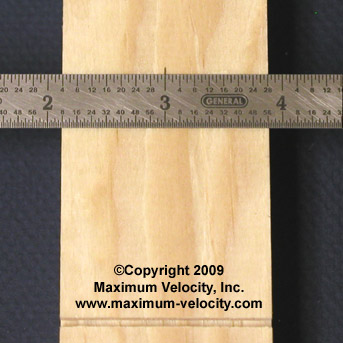
Repeat this technique at another spot on the block, and then connect the two marks.
Pinewood Derby Car Showcase
iPod Jeep: Jeff Jouett
This was my oldest son Jack’s final Pinewood Derby and he wanted something different. The result is the red car. It did play, though not loud enough unless you were right next to it.
Darth Vader: Dan Blythe
Attached is our Darth Vader car my seven year old and I created. I have experimented over the years with paint and making my own decals using pictures off of the Internet, magazines, etc. I give them some special backgrounds and highlights on the computer and then print them on adhesive backed label paper.
The boys pick out the theme, help with the painting, and pick from a variety of decals and where they want them placed on the car. I put it all together with them and teach them some speed tricks along the way.
Music on Wheels: Bruce Edney
My eight year old granddaughter inspired me when she asked me to make a “guitar” pinewood derby car. She sketched a concept and I designed the car based on my old Martin Ukulele that I had on my shelf since high school. The car’s Ukulele is a one-third scale model using Myrtlewood and Purpleheart. The strings are monofilament fish leader. The frets and tuning knobs are brass rod. I finished off the design with piano music copied from a music book and glued to the car body. She named the car, appropriately, “Music on Wheels”. The car won first place in the “Show” class at WIRL in November 2008.
Q&A
Any suggestions on the best way to make stars for the Wedge Turbo? Cutting them from the printout onto a strip of pinstriping is nearly impossible.
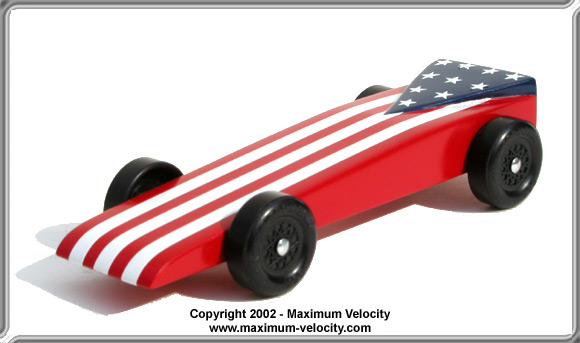
- Look for a sheet of star stickers at a hobby or craft store.
- A good craft store should have a punch that creates stars (scrapbooking section). You could then punch them out of sticker material.
When I try to apply graphite to the wheels, it seems like nothing is coming out of the bottle. If I unscrew the top and clean it out, screw the top back on, and then tap the top of the bottle on a hard surface, I can get some graphite to come out, but I am not sure if tapping on the wheels with the bottle is a good idea because I don’t want to push the axles out of alignment. Is it always like this with graphite, or did I just get a bottle that doesn’t have a wide enough opening on the top?
Graphite isn’t supposed to come out too fast, but it is possible that the bottle you have has too narrow of an opening.
What I do is tap the bottom of the bottle on a work surface (to get all of the graphite at the bottom), and then turn it over and squeeze. This lets the air inside puff out some graphite. If you tap the top, it kind of jams the graphite into the opening which makes it harder to get out.
You can certainly open up the neck a little with a pin or drill bit.
It you get too much out, just dump it off of the wheel. After each application spin the wheels a few times. This works in the graphite and sheds any excess from the wheel bore.
We purchased a set of the Pro-Stock BSA wheels, and we have not modified them at all. When I roll them down an incline (not mounted on the car), they roll to the outside with a defection of 3.5″ over a distance of 20″. All four deflect nearly exactly the same amount.
Should I try to sand the outside edge to make them flat or should I leave them the way they are.
BSA wheels are not symmetrical. They are heavier on the spoke side and lighter on the inside. So, they will tend to pull towards the spoke side when rolled down a level incline.
Of course, once the weight of the car is applied, the load tends to even out across the tread surface.
So no, you don’t want to try to change the tread surface.
Want Answers?
Do you have a pinewood derby-related question? If so, e-mail us your question.We answer all questions by e-mail, but not every question will appear in the Q&A section of the newsletter.
Back Issues
Are you a new subscriber, or have you missed some of the previous newsletters? Don’t miss out; all of the issues for Volume 5 through Volume 17 are posted on our web site.
Newsletter Contributions
We welcome your contributions. If you would like to contribute an article, a web site review, a speed tip, or a pinewood derby memory, please e-mail us.
Subscription Information
The Pinewood Derby Times is a free e-newsletter focused on pinewood derby racing. It is published biweekly from October through March.
If you haven’t already done so, please forward this issue to your pinewood derby friends. But please don’t subscribe your friends. Let them decide for themselves. Thanks.
If this newsletter was forwarded to you, why not subscribe to receive this newsletter. There is no cost, and your e-mail address is safe, as we never sell or share our distribution list.
To subscribe, send a blank e-mail to
pi*********************@*******st.com
You will receive a confirmation e-mail. Reply to the confirmation e-mail and you will start receiving the Pinewood Derby Times with the next issue.
Randy Davis, Editor, Pinewood Derby Times
E-Mail: in**@**************ty.com
(C)2018, Maximum Velocity, Inc. All rights reserved. Please do not reprint or place this newsletter on your web site without explicit permission. However, if you like this newsletter we grant permission, and encourage you to e-mail it to a friend.
Maximum Velocity disclaims any personal loss or liability caused by utilization of any information presented in this newsletter.
The Pinewood Derby Times is not specific to, and is not affiliated with the Boy Scouts of America, YMCA, Awana, or any other organization.
(R)Maximum Velocity is a registered trademark of Maximum Velocity, Inc.
(R)Pinewood Derby is a registered trademarks of the Boys Scouts of America.
(R)Awana is a registered trademark of Awana Clubs International.
All other names are trademarks of their respective owners.

